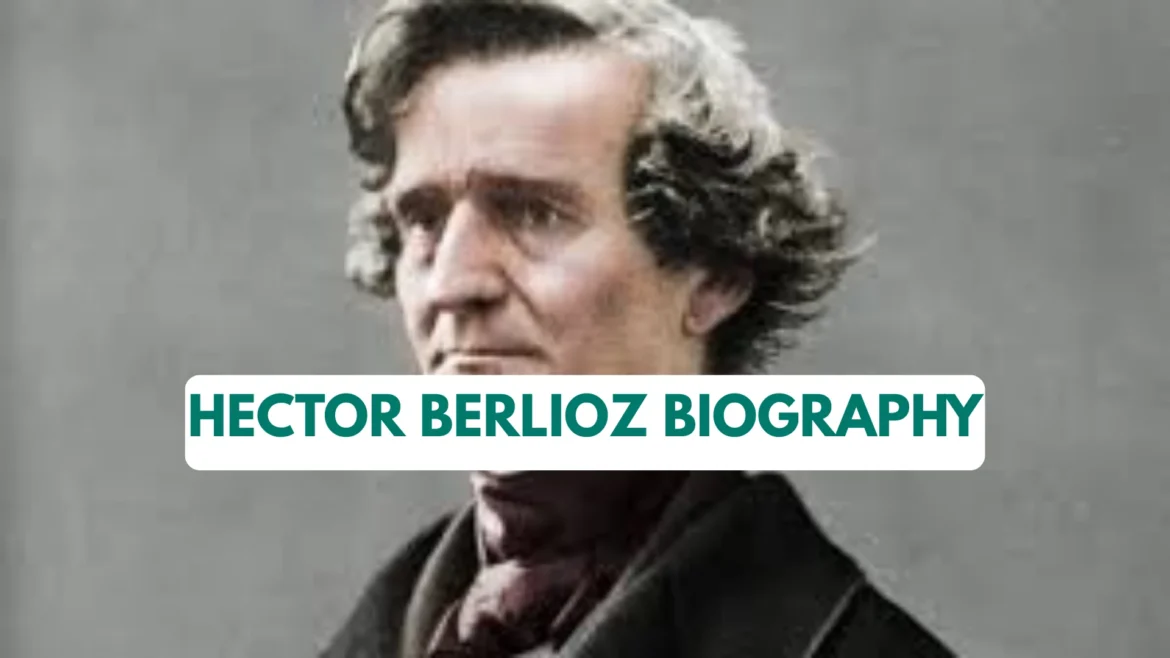Hector Berlioz is one of the towering figures of early Romantic music — a daring orchestral experimenter, brilliant chronicler of extreme emotion, and a writer whose memoirs remain vivid and entertaining.
From the stormy drama of Symphonie fantastique to the vast theatrical sweep of Les Troyens, Berlioz reshaped orchestral color, programmatic narrative, and modern ideas about instrumentation. This biography explores his life, musical breakthroughs, major works, relationships, and enduring influence.
Bio Data
- Full Name: Louis-Hector Berlioz
- Born: December 11, 1803
- Died: March 8, 1869
- Age at Death: 65
- Birthplace: La Côte-Saint-André, Isère, France
- Nationality: French
- Occupation: Composer, conductor, writer, music critic
- Parents: Father: Louis-Joseph Berlioz; Mother: Marie-Antoinette Joséphine (née Marmion)
- Siblings: Nanci and Adèle (surviving)
- Spouse(s):
- Harriet Smithson (m. 3 October 1833)
- Marie Geneviève “Marie” Recio (née Martin) (m. 19 October 1854)
- Children: Louis Berlioz
- Religion: Agnostic (his father was agnostic; his mother was Roman Catholic)
- Net Worth: ~ US$ 5 million (according to Celebrity-Birthdays)
Early Life and Background
Louis-Hector Berlioz was born on December 11, 1803, in La Côte-Saint-André, in the Isère region of France. The son of a provincial doctor, young Hector initially trained for medicine at his father’s urging, but he was restless and drawn to music and literature from an early age. By his late teens he had abandoned medicine for composition and the dramatic arts — an unusual and contentious choice in a family that expected the security of a medical profession.
At the Paris Conservatoire, Berlioz studied composition and found patrons among the musical intelligentsia. His musical voice was bold and idiosyncratic; he valued dramatic expression and vivid orchestral color over elegant, conservative forms. Those traits would make him both admired and controversial throughout his career.
Struggle, Recognition, and the Prix de Rome
Berlioz’s path to recognition was not straightforward. He famously entered the prestigious Prix de Rome competition multiple times before finally winning first prize in 1830. The Prix de Rome provided a vital stipend and a period of study in Italy — both of which supported Berlioz’s development as a composer and helped him produce some of his most imaginative large-scale works. His repeated attempts and eventual victory are told vividly in his Memoirs, where he depicts the Conservatoire’s judges as the guardians of musical orthodoxy he sought to challenge.
Symphonie fantastique — The Breakthrough
In 1830 Berlioz composed what would become his most famous and revolutionary work: Symphonie fantastique. Written in a fever of obsessive imagination, the symphony is a programmatic tour through love, despair, opium dreams, and hellish visions — all organized around the recurring idée fixe (a melodic symbol of the beloved). The piece brought radical new orchestral colors, lurid narrative, and dramatic effects (bells, col legno strings, and grotesque choruses) into symphonic form, helping inaugurate the French Romantic orchestral tradition. Its premiere shocked and astonished Paris and established Berlioz as a singular creative force.
Love and Obsession: Harriet Smithson
A key human story in Berlioz’s life — and the emotional seed for Symphonie fantastique — was his obsession with the Anglo-Irish actress Harriet Smithson. After seeing her perform roles such as Ophelia and Juliet in Paris, Berlioz became consumed by a romantic ideal inspired by her stage portrayals. Initially ignored, he persisted; after Symphonie fantastique and its sequel Lélio made the connection public, Smithson eventually acknowledged him and they married in October 1833. The marriage, however, proved unhappy and eventually dissolved, a painful episode that Berlioz later described with candor.
Major Works and Musical Innovations
- Symphonie fantastique (1830) — the groundbreaking program symphony that fused narrative and orchestral innovation.
- Harold en Italie (1834) — a symphony with viola obbligato, written after Niccolò Paganini encouraged Berlioz to compose for the viola.
- La damnation de Faust (1846) — a dramatic legend blending opera, oratorio, and concert drama elements.
- Les Troyens — Berlioz’s grand opera after Virgil’s Aeneid, massive in scale and one of his most ambitious achievements.
- Grande Messe des morts (Requiem) — a monumental liturgical work demonstrating his mastery of massive sonorities.
Berlioz loved exploring instrumental color: novel combinations of winds, brass, percussion, and strings, and techniques like col legno (striking strings with the wood of the bow). His orchestration handbook and his lengthy writings on music influenced generations of composers and conductors who followed.
Career, Criticism, and Later Life
Although his compositions brought him fame, they did not always bring financial security. Berlioz sustained himself partly by working as a critic — a role he performed with mordant wit and uncompromising judgments. He also toured as a conductor later in life, gaining recognition abroad, particularly in Germany and Britain, where audiences were often more receptive than in conservative French institutions.
Late in life he experienced both triumphs and disappointments. His monumental opera Les Troyens was never staged in its entirety during his lifetime, and theater management politics and financial realities often curtailed his ambitions. Berlioz’s wife (Harriet Smithson) died in 1862, and Berlioz lived his final years reflecting on a career that blended creative daring with personal turbulence. He died in Paris on March 8, 1869.
Writing, Memoirs, and Influence
Berlioz was an articulate and vivid writer. His Memoirs are a lively primary source for his life, opinions, and the musical scene of 19th-century Europe. Beyond his own compositions, his ideas about orchestration and dramatic narrative shaped later composers — Wagner, Liszt, Mahler, and the French orchestral school all acknowledged debt to Berlioz’s exploratory spirit. The sound-world he created, and his insistence on emotional truth and sonic imagination, helped define the Romantic era’s expressive possibilities.
FAQs
When was Hector Berlioz born and when did he die?
Born December 11, 1803 — died March 8, 1869.
What is Symphonie fantastique about?
A program symphony depicting an artist’s obsessive love and a descent into dreamlike horrors and hellish visions.
Did Berlioz win the Prix de Rome?
Yes — after multiple attempts, he won first prize in 1830.
Who inspired Berlioz’s obsession?
Actress Harriet Smithson inspired the dramatic image that became the emotional heart of Symphonie fantastique.
Conclusion
Hector Berlioz was a restless musical innovator whose bold orchestration, dramatic imagination, and uncompromising temperament made him one of the Romantic era’s most distinctive figures. His music pushed orchestral color and narrative to new limits; his writings clarified and argued for a modern musical sensibility; and his influence echoes in composers who followed. Though often misunderstood in his lifetime, Berlioz’s legacy today is secure: he enlarged the possibilities of what music could express and how an orchestra could paint emotion on a grand canvass.




